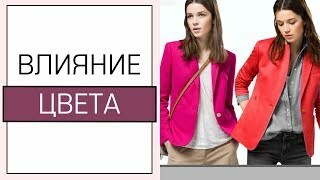Since ancient times colors have been given importance, now it is known the special influence of this or that color on the consciousness of a person. The psychology of color perception can tell a lot about a person, his character, his psychological state.
Lusher color test
Many psychologists have studied the meaning and influence of color. As a result of their work, a color psychological test was developed, which Dr. Max Lyusher developed. Conducting color diagnostics Lusher allows you to draw conclusions about the patient's psychophysiological state, its activity, stress resistance, communicative abilities. It is also actively used to determine the causes of psychological stress.
According to the doctor, the choice of color occurs unconsciously, but can show the direction of a person to a certain type of activity, reflect his mood and inner state.
To perform the Luscher test, you must select one color from all offered. In this case, it is important to focus only on the shade, without trying to link it with any objects. Choose one color until the color set changes. After the end of the test, results with a sufficiently detailed and interesting analysis become available.
The meaning of color in psychology
What do colors in psychology mean, what color clothes are most appropriate in one or another case, what does the preference for these or those shades indicate? The answers to all questions are scientifically grounded. Color is not only bright colors. It is also called a powerful tool of influence on the human psyche. The meaning of colors in psychology, this or that attitude towards them can reveal the mystery of the development and formation of a person's personality.
Each color in psychology affects the mind in different ways, causing certain emotions, raising or lowering the mood. A certain choice people often make under the influence of color, without even thinking about the decision. So, blue is used in politics, red is in advertising, and machines of influential people are often black. In order to skillfully use the properties of color, you need to know the meaning of the basic colors in psychology.
Purple color in psychology
The value of purple in psychology is associated with observation, vanity, wit and increased sensitivity. This color is complex, it is formed by a combination of opposite in meaning two colors - red and blue, so people who prefer purple color are extremely contradictory and secretive. To understand them is often beyond the power of even close people. With the help of various shades of purple, people can express their individuality and sensuality. Creative and sensitive people purple color easily adjusts to positive vibration. Shades of purple color can also help people experiencing mental imbalance and nervous tension. Violet color positively influences various forms of neuroses, affecting the nervous system and restoring harmony and balance in one's personal life, increasing a person's self-esteem.
Blue in Psychology
One of the most "strong" in psychology is blue, which has two opposite properties. On the one hand, the blue color acts soothingly on the psyche, relieves stress and relaxes. The contemplation of the sky-blue sky or sea surface removes tension, causes a sense of peace and tranquility. On the other hand, a deep intense blue( indigo) color can oppress, suppress and even cause or intensify depression. Therefore, use the blue color with caution.
In psychology, blue is most often associated with physical and psychological health, satisfaction with life and self-confidence, so its people choose successful and strong, striving for harmony with everything around them. Nevertheless, to abuse the use of blue color is not worth it, because having a great power and energy, in different situations it can have different, often opposite effects on people. In addition, it is not recommended to use blue in the case when considerable mental stress, concentration and concentration are required, for example, it is not necessary to use this color in the design of the study.
Green in Psychology
The value in the psychology of green is the most multifaceted and diverse and represents a willingness to contemplate and accept universal wisdom. Green color is most calmly perceived and favorably affects the whole organism, associated with awakening and stability, provides relaxation and heals.
Different shades of green have a different interpretation and have different effects on the human nervous system. So, coniferous tone means strength, stability and durability, it is chosen by self-confident people who have a stable life position. A gentle shade of sage and moss can have a calming effect, and malachite and emerald indicate a craving for wealth.
The use of green in medicine helps to normalize pressure, palpitations.
Yellow in psychology
Yellow is the color of the sun, the color of joy, hope and faith. Yellow color stimulates the nervous system and brain activity of a person, but too long its effect can lead to overload and overexcitation. This color in psychology is associated with the need for development, self-disclosure, yellow - a symbol of liberation from tension and irritation. People who prefer yellow color, strive to realize themselves in all spheres of life, to reveal their talents, but the opinion of others can be very tough and critical. Disappointed people reject the yellow color, so, alcoholics and drug addicts do not like yellow shades.
Orange color in psychology
Orange color is most often associated with sun and heat. This is the color of high mood, cheerfulness, the solution of important tasks. People who choose orange, strong and freedom-loving, emitting "solar" energy, they charge it all around them. Such a person easily enjoys simple things, but often suffers from experiences that arise on an intuitive level.
According to psychologists, this color is able to revive emotions, it is a color - a vitamin that significantly improves tone and induces a burst of vitality, it is also an excellent antidepressant. Orange color can be useful for cowardly people, but its overabundance can cause irritation.
Red in psychology
Psychology of red color warns of aggressiveness and danger. Red color is active and hot, can cause anxiety and anxiety, increased heart rate and pulse, increased blood pressure, so it is not recommended to look at it for a long time. For this reason, designers are very cautious in using this color in interior design, but in advertising red is irreplaceable, because it easily attracts everyone's attention.
Under the influence of red color, positive and negative character traits are formed in a person: courage, perseverance, determination, perseverance, cruelty, intolerance, greed, selfishness, imperiousness. Lovers of red color tend to dominate and be the first in everything. Only "red" by nature a man looks harmoniously in red and can eat his energy. The abundance of red color causes irritation and even rage. The combination of red with more tranquil colors is harmonious.
Psychology of color in clothes

Earlier the psychology of colors in clothes was not sufficiently studied and even considered something mystical. However, today it is proved that a person does not accidentally choose clothes of certain colors - the selection of shades occurs intuitively and becomes a reflection of the general state.
Clothing of white color is considered "ideal", since this color is a kind of synthesis of all shades. People who choose this color appreciate physical and spiritual purity. Such a person is creative, but not persistent enough.
Lovers of black color in clothes are considered to be insecure, withdrawn, focused on themselves and inclined to dramatize what is happening around. The predominance of black clothes in the wardrobe may also indicate that a person is too aggressive towards the world, and also to himself. However, at the same time, such a person can be quite calm and have a well-developed creative principle.
The predominance of shades of gray in clothes can talk about discretion and some mistrust. Such a person thinks about the decision for a long time, is afraid to stand out from the crowd, trying to merge with it as much as possible. For the ardent opponents of gray in clothing characteristic is considered impulsive and quick-tempered character.
Brown clothes are popular with people for whom family and traditions are of great value. Such a person is simple and can enjoy simple things. However, the shades of brown can talk about some weakness in the physical and emotional terms.
The possessor of pink clothes is sensual, tender and positive, she is able to express her love clearly. Such a woman can be very vulnerable and sensitive, but she forgets very quickly. Lovers of pink color need care and protection of others, as often enough they feel alone. The choice in favor of a bright pink color will make a certain rebel, an easy and cheerful person.
Thus, color plays a big role in understanding the inner world of man. This is a kind of signal not only for others, but also for oneself, for to know oneself means to find harmony. Video:
 5:06
5:06  4:01
4:01  6:05
6:05 